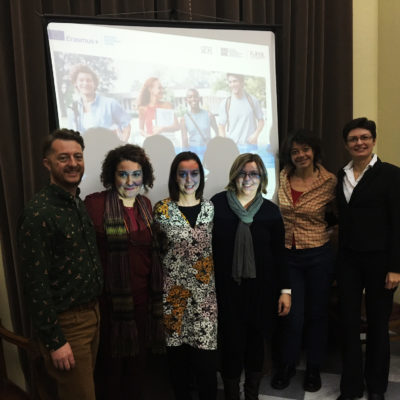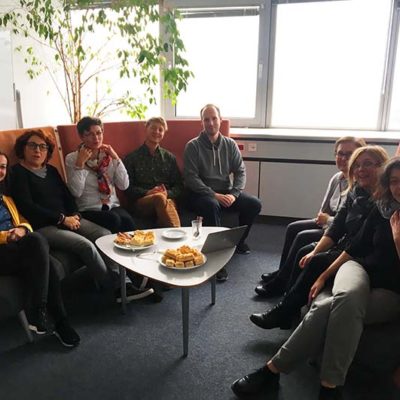Hannover Multiplier Event
The first Multiplier Event of EU-MADE4LL took place on 29th September 2017 in Hannover. It was the ideal venue for the Project Partners to introduce the first intellectual output developed in Year 1, namely the EU-MADE4LL e-learning platform, to a varied and receptive audience of guests and prospect stakeholders including academics, school teachers, teacher trainers, researchers, digital and multimodal analysts.
The Multiplier Event was hosted by Ivana Marenzi, who welcomed the guests by presenting the mission of the L3S Research Centre, and it opened with presentations by the Project Coordinator, Maria Grazia Sindoni, and by Sandra Petroni, who illustrated background, motivation, and rationale of the project. The latter started as a pilot project involving four Italian Universities and, thanks to its positive outcomes, was then exported in an international context so as to frame it in a transnational dimension with the contribution of Leeds and Aarhus universities.
Each partner then gave a short explanation of their role in the project, also pointing out the issues and challenges (both ethical and organizational) faced when exporting the project into an international context. Elisabetta Adami (University of Leeds) highlighted the issue of finding a common denominator policy in terms of ethical treatment of students’ sensitive data, as the joint syllabus will involve the production of digital texts which may reveal students’ identities, not to mention the problem of recruiting students within curricular contexts where they may feel forced to give their explicit consent to store sensitive contents. All these ethical issues have been carefully dealt with during the first year of the project, resulting in a portfolio of all procedures which was officially approved by the University of Leeds Ethical Committee, which was the strictest institution among all partners as far as ethics was concerned.
Ilaria Moschini (University of Florence) focused on the issue of adapting the project into different academic contexts and course requirements (e.g. ECTS, core and secondary readings, evaluation grids, assessment criteria and peer-assessment forms), while Carmen Daniela Maier (Aarhus University) drew attention on the students’ expectations about how a multimodality module can be integrated into their studies on corporate discourse by specifically focusing on how multimodal and digital skills are required in the job market and not exclusively from a technical standpoint.
The challenges have been addressed by the project partners, for example by establishing a shared ethics policy across the five universities, and by underscoring the advantages coming from developing the students’ ability in designing, analysing, and evaluating digital texts in a world where communication is increasingly multimodal. Peer assessment was also discussed as a key aspect of the project, by which students are led to reflect on their own work and their peers’. A further asset of the project is the partnership with Marc Rocca, MD of Rocca Creative Thinking UK. Marc Rocca explained how students will put their coursework to the test by tackling realistic work scenarios during hands-on workshops at Rocca in Sheffield.
Ivana Marenzi took the floor again to illustrate the features and functionalies of the EU-MADE4LL Design Framework and Platform developed by the researchers at L3S, which will be used for the project and is already being used for educational purposes– e.g. by Maria Bortoluzzi (University of Udine),who, in the afternoon session, presented the YELL/TELL community, where teachers use the platform to generate and share multimodal resources for English language learners. Further insights came from the invited speakers.
Melinda Dooly (Univeristat Autonoma de Barcelona) illustrated the FIT pedagogical model (Flipped & In-class instruction & Telecollaboration) whereby students training to become language teachers in Spain engage in online collaborative activities with their colleagues in the US; Francesca Coccetta (University of Ca’ Foscari, Venice) emphasized the need for language teachers to teach multimodality and provided some practical examples of how to analyse and reflect on a range of different multimodal texts.
Lastly, a very interesting contribution came from Digital Analysts Ralph Ehwert and Eirini Noutzi (University of Hannover), who showed how multimodal information can be used for searching image and video data, and for developing sentiment analysis research, which can then find a number of applications (educational, commercial, political). Both partners’ and invited presentations were followed by a lively ‘question time’ during which the participants expressed their appreciation of the project and gave constructive feedback – also on how the project could be implemented in other educational contexts – which the partners will take into consideration to further develop the project.
By Roberta Signorino



















